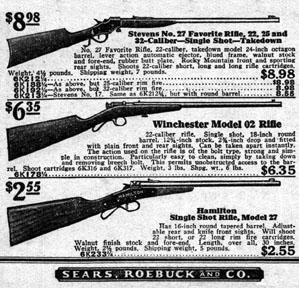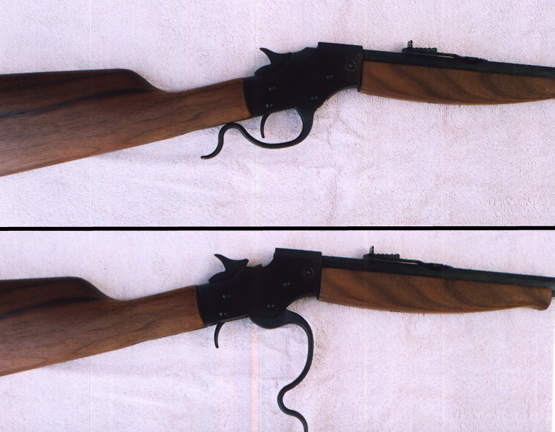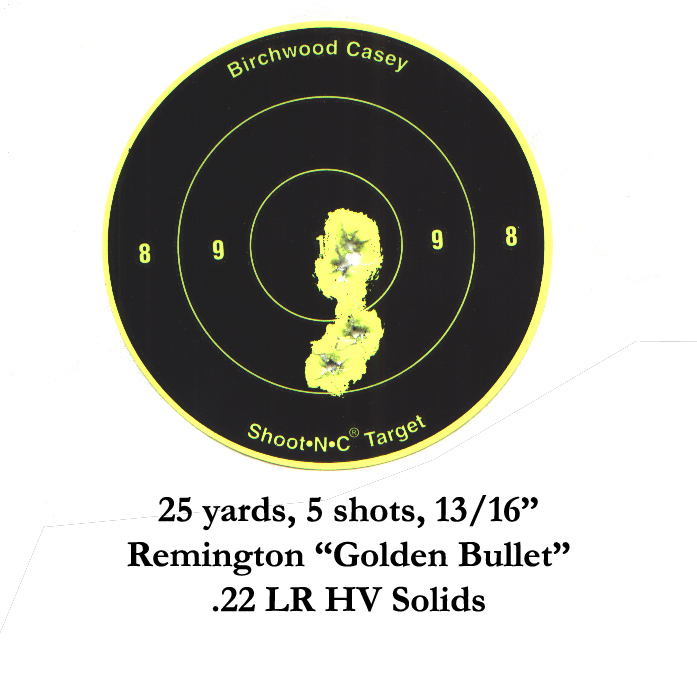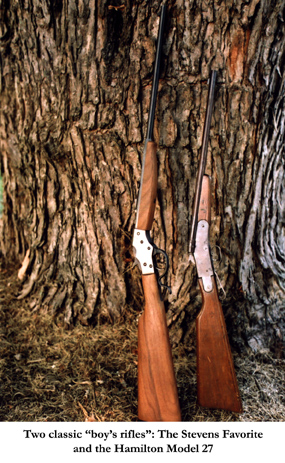RETURN OF A FAVORITE
Although it’s hard to imagine nowadays, not so very long ago it wasn't socially unacceptable (in some places, actually a criminal act) to give a responsible 10- or 12-year old boy a .22 rifle, show him how to use it, and let him have fun. Almost every gun maker produced a "boy's rifle," generally an inexpensive single-shot, to serve this segment of the market. Boys armed with these little rifles hunted squirrels and rabbits and burned up millions of rounds of .22 ammunition on tin cans, bottles, rats and other vermin and similar “targets of opportunity.” Shooting and gun ownership were so completely a part of normal life and growing up that a few manufacturers even formed special “junior rifle clubs” to encourage sales of their products.
 While there were one or two firms (most prominently the C.J. Hamilton Company) whose entire production was low-cost .22’s, boy’s rifles were usually just one component of a manufacture’s overall product line. The J. Stevens Arms & Tool Company was probably the most prolific maker of good-quality boy’s rifles, turning out vast numbers of them for many years. Pre-eminent among Stevens’ products of this type was the aptly-named “Favorite.” The Favorite was chambered for .22, .25, and .32 rimfire calibers and came in a number of minor variations; at least a million original Favorites were produced between 1893 and 1939. The original Favorite was by no means a cheap gun: it was actually the most expensive single-shot .22 boy’s rifle listed in the 1927 Sears, Roebuck catalog. Other Stevens .22’s sold for prices ranging from $3.80 for the “Junior” to $12.50 for a pump-action repeater. The Hamilton Model 27 was by far the cheapest.
While there were one or two firms (most prominently the C.J. Hamilton Company) whose entire production was low-cost .22’s, boy’s rifles were usually just one component of a manufacture’s overall product line. The J. Stevens Arms & Tool Company was probably the most prolific maker of good-quality boy’s rifles, turning out vast numbers of them for many years. Pre-eminent among Stevens’ products of this type was the aptly-named “Favorite.” The Favorite was chambered for .22, .25, and .32 rimfire calibers and came in a number of minor variations; at least a million original Favorites were produced between 1893 and 1939. The original Favorite was by no means a cheap gun: it was actually the most expensive single-shot .22 boy’s rifle listed in the 1927 Sears, Roebuck catalog. Other Stevens .22’s sold for prices ranging from $3.80 for the “Junior” to $12.50 for a pump-action repeater. The Hamilton Model 27 was by far the cheapest.
The demands of World War Two and its aftermath, as well as the changing social attitudes towards firearms of the 1960’s and later were significant factors in the decline of the boy’s rifle genre, but the concept of a reliable, safe, and inexpensive rifle suitable for young shooters has never quite died out; single-shot .22’s, mostly bolt actions, are still made as an entrée into the shooting game for youngsters. Now Savage Arms, the direct lineal descendant of Joshua Savage’s 19th Century company, has brought back the Stevens Favorite as another and very welcome addition to the field.
 I was in a gun shop to get some minor work done on a shotgun, and they had one of these lethally cute little guns on the rack. I asked to see it and immediately committed an act of which my wife would surely not have approved. A little paperwork was done, money changed hands, and off to the range I went with my new toy. Toy-like it may appear, but the "Stevens Favorite Model 30," as Savage has named it, is one fine little rifle. This trim and attractive .22 is well suited to new shooters, but also to hikers, campers, back-packers, and anyone who just wants to have a good time with a quintessential “fun gun.”
I was in a gun shop to get some minor work done on a shotgun, and they had one of these lethally cute little guns on the rack. I asked to see it and immediately committed an act of which my wife would surely not have approved. A little paperwork was done, money changed hands, and off to the range I went with my new toy. Toy-like it may appear, but the "Stevens Favorite Model 30," as Savage has named it, is one fine little rifle. This trim and attractive .22 is well suited to new shooters, but also to hikers, campers, back-packers, and anyone who just wants to have a good time with a quintessential “fun gun.”
Externally the standard fixed-frame Favorite, which I purchased, looks pretty much exactly like its pre-war namesake. There are internal mechanical differences and the materials and processes used are fully modern, but the overall “look” is very retro, very late-19th Century. Although this is a recreation of a famous American firearm, the Model 30 is marked "Savage Arms Inc. Lakefield, Ont. Canada," as it’s actually manufactured in Savage’s Canadian facilities.
Several versions are in production including a take-down model. Both the solid frame and take-down variants come in .22 Long Rifle and .22 WMR; and inevitably, the popular .17 HMR has been added to the caliber list. (No doubt a .17 Mach 2 chambering is in the works.) There's a variant with a camouflage paint job (why? why?) for those who have the itch to spend an extra $40 or so, but the basic rifle comes with a very handsome “walnut look” hardwood stock.
That phrase has been used to describe some really dreadful stocks on cheap guns, and Savage has been responsible for many of them; but the Model 30 Favorite’s stock and fore-end are made from dense, close-grained wood that really does resemble walnut. The deep stain and matte finish increase the resemblance. The buttplate is plain black plastic with horizontal grooves, nicely fitted to the stock. The fore-end is held in place by a screw. Length of pull is shorter than full-sized rifles, only 13-1/2”, so it’s well suited to young shooters and those of small stature. The balance point is exactly where it should be, right where the barrel joins the receiver. The small dimensions, light weight, and good balance make it easy to carry in one hand. There are no sling swivels, though these could certainly be installed.
The 21-inch barrel is half-octagon in form, with the octagonal portion ending at the front of the fore-end. The receiver, trigger, hammer, and under-lever are investment castings, matte-finished in a deep black; the case-hardened finish of the old guns is prettier by far, but case-coloring is prohibitively expensive today. Sights are a ramp- and drift-adjustable U-notch rear and a bead front. Both are dovetailed into the barrel, and were spot on for me when I took the rifle out of the box and began firing it.
The action is a falling block type with an external hammer. Wonder of wonders, the lawyers didn't force Savage to include a cross-bolt safety or trigger block. There's a half-cock notch, which is all the safety that's needed on a rifle like this one. The lawyers’ influence is evident in the packaging: the Favorite comes with a special trigger and lever lock to prevent unauthorized use, and a set of foam ear plugs.
 Pulling the lever down opens the action and cams the breechblock back and downwards. A round is chambered manually, the lever is raised, and the hammer is thumb cocked for the shot. The hammer can’t be cocked with the action open; and working the lever while the hammer is cocked causes it to fall. It’s impossible to cock the hammer first, load a round, and close the breech, leaving the rifle in an unsafe condition. Working the lever always leaves the hammer all the way forward in the “fire” position. There’s no hammer rebound, but the Favorite has an inertial firing pin which must be struck with the full force of the hammer spring to set the cartridge off.
Pulling the lever down opens the action and cams the breechblock back and downwards. A round is chambered manually, the lever is raised, and the hammer is thumb cocked for the shot. The hammer can’t be cocked with the action open; and working the lever while the hammer is cocked causes it to fall. It’s impossible to cock the hammer first, load a round, and close the breech, leaving the rifle in an unsafe condition. Working the lever always leaves the hammer all the way forward in the “fire” position. There’s no hammer rebound, but the Favorite has an inertial firing pin which must be struck with the full force of the hammer spring to set the cartridge off.
I chambered a case and lowered the hammer to its fully-down position, then smartly rapped the tail of the hammer with a wooden block, to simulate dropping the rifle onto a hard surface. Since the firing pin is shorter than the distance from the hammer face to the rim of the round, the cartridge was completely untouched. If the hammer is set on half-cock and the trigger pulled, it will drop, but again, the case remains untouched because there is nowhere near enough force to dent the rim. . Savage recommends the fully-down position as the “safe” one when there’s a round in the chamber, the design makes it safe to carry the Favorite loaded with the hammer down, or set on half-cock. The trigger pull is fairly heavy but reasonably crisp in let-off without much creep. I’ve had rifles with better out-of-the-box triggers, but I’ve also had many that were far worse, and I’ve no complaints about this one.
 My eyes aren't all that well adapted any more to open sights, but from a rest using Remington's “Golden Bullet” 40-grain solids, even I was easily able to keep all my shots inside an inch at 25 yards. While the barrel is marked ".22 Long Rifle Only," I simply had to try it with Shorts. If ever I saw a gun that begs to be used with Shorts, this is it. Unfortunately it doesn't shoot Shorts all that well: the CCI hollow-point high-velocity Shorts I prefer for small game hunting weren’t as accurate as the “Golden Bullet" .22 LR but there are many brands I haven’t had time to test, and I haven’t given up on Shorts just yet. I also tried Winchester's “Power Point” 40-grain HP's and got groups averaging 1.5" center-to-center, the same as with the CCI Shorts.
My eyes aren't all that well adapted any more to open sights, but from a rest using Remington's “Golden Bullet” 40-grain solids, even I was easily able to keep all my shots inside an inch at 25 yards. While the barrel is marked ".22 Long Rifle Only," I simply had to try it with Shorts. If ever I saw a gun that begs to be used with Shorts, this is it. Unfortunately it doesn't shoot Shorts all that well: the CCI hollow-point high-velocity Shorts I prefer for small game hunting weren’t as accurate as the “Golden Bullet" .22 LR but there are many brands I haven’t had time to test, and I haven’t given up on Shorts just yet. I also tried Winchester's “Power Point” 40-grain HP's and got groups averaging 1.5" center-to-center, the same as with the CCI Shorts.
This little rifle shoots better than my old eyes will see, but I'd not desecrate it with a scope. Now, a tang peep sight is another matter: the original Favorite came with a folding tang sight, and one could easily be added to the Model 30 by a gunsmith. I’d have preferred a gold bead on the front sight to the black one. Gold bead front sights with U-notches are fast and accurate and easy to pick up in dim light. A dab of paint would fix this, and no doubt any number of replacement sights would work.
All that said, at 25 to 50 yards, I’m a serious danger to any small game animal, right now, and this is the sort of gun whose preferences and quirks you learn by actually shooting it in the field. After I've put a few hundred more rounds through it I'll be able to hit anything I want to within its effective range. It’s such a handy little thing that using it effectively is a matter of taking advantage of its innate qualties for instinctive shooting, rather than formal target practice.
 Long rifle cases were extracted but not ejected. I usually had to pull them out with my fingers. But if I held the rifle vertically, some cases would fall out on their own. A little more use and/or a chamber polishing may correct this; it’s a breaking-in issue and I haven’t shot more than 100 rounds yet. Cases from Shorts were always fully removed from the chamber and fell to the ground.
Long rifle cases were extracted but not ejected. I usually had to pull them out with my fingers. But if I held the rifle vertically, some cases would fall out on their own. A little more use and/or a chamber polishing may correct this; it’s a breaking-in issue and I haven’t shot more than 100 rounds yet. Cases from Shorts were always fully removed from the chamber and fell to the ground.
I'm not sure what the logic of making this rifle in .22 WMR and .17 HMR may be. The Favorite is a simon-pure plinker, a gun that’s intended to be shot and shot and shot. I can buy Remington's .22 LR solids locally for about $9 per 500 rounds: the .22 Magnum costs $6.00 or so for 50 rounds, and .17 HMR─if you can find it─is at least twice that. While I can understand Savage's desire to capitalize on the current craze for .17's, if the idea is to encourage shooting, obviously .22 LR makes far more sense.
The original Favorite also came in .25 Rimfire and .32 Rimfire, neither of which is readily available any more. But….it wouldn't be difficult for Savage to make a version chambered in .32 S&W Long, a reloadable centerfire round. This would resurrect the "big bore" Favorites of yesteryear, and the .32 S&W Long is an outstanding small game caliber when used in a rifle. If Savage did this, I’d be the first person to put in an order!
I got my first .22 at age 12 or so, and having this little gun in hand was like being a kid again. It's a shame that today’s parents have been browbeaten out of giving their youngsters guns, and in some cases legally prohibited from doing so under any circumstances. It speaks volumes for the way the world has changed that even when it is legal to allow a child to engage in safe, supervised shooting, parents who do so are practically accused of child abuse. The Model 30 Favorite is just about perfect as a way to introduce a responsible kid to the pleasures of shooting. I haven't had so much fun with a new .22 in a long time. In fact, not since I was 12 years old.
FIRST KILL WITH THE NEW FAVORITE!
 While there were one or two firms (most prominently the C.J. Hamilton Company) whose entire production was low-cost .22’s, boy’s rifles were usually just one component of a manufacture’s overall product line. The J. Stevens Arms & Tool Company was probably the most prolific maker of good-quality boy’s rifles, turning out vast numbers of them for many years. Pre-eminent among Stevens’ products of this type was the aptly-named “Favorite.” The Favorite was chambered for .22, .25, and .32 rimfire calibers and came in a number of minor variations; at least a million original Favorites were produced between 1893 and 1939. The original Favorite was by no means a cheap gun: it was actually the most expensive single-shot .22 boy’s rifle listed in the 1927 Sears, Roebuck catalog. Other Stevens .22’s sold for prices ranging from $3.80 for the “Junior” to $12.50 for a pump-action repeater. The Hamilton Model 27 was by far the cheapest.
While there were one or two firms (most prominently the C.J. Hamilton Company) whose entire production was low-cost .22’s, boy’s rifles were usually just one component of a manufacture’s overall product line. The J. Stevens Arms & Tool Company was probably the most prolific maker of good-quality boy’s rifles, turning out vast numbers of them for many years. Pre-eminent among Stevens’ products of this type was the aptly-named “Favorite.” The Favorite was chambered for .22, .25, and .32 rimfire calibers and came in a number of minor variations; at least a million original Favorites were produced between 1893 and 1939. The original Favorite was by no means a cheap gun: it was actually the most expensive single-shot .22 boy’s rifle listed in the 1927 Sears, Roebuck catalog. Other Stevens .22’s sold for prices ranging from $3.80 for the “Junior” to $12.50 for a pump-action repeater. The Hamilton Model 27 was by far the cheapest. I was in a gun shop to get some minor work done on a shotgun, and they had one of these lethally cute little guns on the rack. I asked to see it and immediately committed an act of which my wife would surely not have approved. A little paperwork was done, money changed hands, and off to the range I went with my new toy. Toy-like it may appear, but the "Stevens Favorite Model 30," as Savage has named it, is one fine little rifle. This trim and attractive .22 is well suited to new shooters, but also to hikers, campers, back-packers, and anyone who just wants to have a good time with a quintessential “fun gun.”
I was in a gun shop to get some minor work done on a shotgun, and they had one of these lethally cute little guns on the rack. I asked to see it and immediately committed an act of which my wife would surely not have approved. A little paperwork was done, money changed hands, and off to the range I went with my new toy. Toy-like it may appear, but the "Stevens Favorite Model 30," as Savage has named it, is one fine little rifle. This trim and attractive .22 is well suited to new shooters, but also to hikers, campers, back-packers, and anyone who just wants to have a good time with a quintessential “fun gun.”  Pulling the lever down opens the action and cams the breechblock back and downwards. A round is chambered manually, the lever is raised, and the hammer is thumb cocked for the shot. The hammer can’t be cocked with the action open; and working the lever while the hammer is cocked causes it to fall. It’s impossible to cock the hammer first, load a round, and close the breech, leaving the rifle in an unsafe condition. Working the lever always leaves the hammer all the way forward in the “fire” position. There’s no hammer rebound, but the Favorite has an inertial firing pin which must be struck with the full force of the hammer spring to set the cartridge off.
Pulling the lever down opens the action and cams the breechblock back and downwards. A round is chambered manually, the lever is raised, and the hammer is thumb cocked for the shot. The hammer can’t be cocked with the action open; and working the lever while the hammer is cocked causes it to fall. It’s impossible to cock the hammer first, load a round, and close the breech, leaving the rifle in an unsafe condition. Working the lever always leaves the hammer all the way forward in the “fire” position. There’s no hammer rebound, but the Favorite has an inertial firing pin which must be struck with the full force of the hammer spring to set the cartridge off.  Long rifle cases were extracted but not ejected. I usually had to pull them out with my fingers. But if I held the rifle vertically, some cases would fall out on their own. A little more use and/or a chamber polishing may correct this; it’s a breaking-in issue and I haven’t shot more than 100 rounds yet. Cases from Shorts were always fully removed from the chamber and fell to the ground.
Long rifle cases were extracted but not ejected. I usually had to pull them out with my fingers. But if I held the rifle vertically, some cases would fall out on their own. A little more use and/or a chamber polishing may correct this; it’s a breaking-in issue and I haven’t shot more than 100 rounds yet. Cases from Shorts were always fully removed from the chamber and fell to the ground.